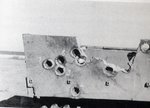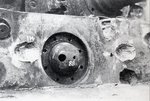- Thread starter
- #21
delcyros
Tech Sergeant
To make it repeatable, I give my approximations for the D-10 ballistics:
gun: D10
nation: soviet
timeframe: mid-late ww2
Caliber = 3.9 inch (10.0 cm)
Shell weight = 35 lbs (16 kg)
Muzzle velocity = 2922 fps (891 m/s)
plate thickness in calibres = 1.8
Relative ballistic performance: 1.00 (my assumption, but soviet ballistic
projectiles were not bad in comparison to other. I might be wrong here)
Muzzle energy = 6.262 megajoules = 2307.6 foot-tons
Relative muzzle energy: 1.18
Elevation-----Range --------Time-----Velocity----Fall Angle--effect*:
0.0 deg-----~300 yards----0.1 sec--2896 fps----0.1 deg---1886 fps
0.5 deg-----1400 yards----1.6 sec--2561 fps----0.6 deg----1318 fps
1.0 deg-----2500 yards----3.1 sec--2295 fps----1.2 deg----676 fps
1.2 deg-----3100 yards----3.7 sec--2204 fps----1.5 deg----234 fps
1.3 deg-----3300 yards----4.0 sec--2161 fps----1.7 deg----plate holed normal plug punched out
1.4 deg-----3500 yards----4.2 sec--2134 fps----1.8 deg----no holing of the plate
1.5 deg-----3700 yards----4.5 sec--2094 fps----1.9 deg----no holing of the plate
1.6 deg-----3900 yards----4.8 sec--2055 fps----2.1 deg----no holing of the plate
2.0 deg-----4600 yards----5.9 sec--1925 fps----2.7 deg----no holing of the plate
2.5 deg-----5400 yards----7.3 sec--1783 fps----3.6 deg----no holing of the plate
5.0 deg-----8600 yards----13.4 sec-1360 fps----8.3 deg----no holing of the plate
7.5 deg-----10800 yards---18.9 sec-1140 fps----13.8 deg---no holing of the plate
10.0 deg-----12600 yards---23.9 sec-1014 fps----19.6 deg--no holing of the plate
(excluding fractions)
*) means effect on plate (holed or not), resp. the remaining projectile velocities in case the plate is defeated.
Assuming no hit on the bulge of the gunmount (in most cases the projectile would glance off anyway). Armour properties:
Q=0.95, E=15%, armour tends to be brittle, NO FACE HARDENED TYPE (?not sure in this?)
Thickness: 180 mm, no backing plate, inclined back by 10 degrees from the vertical
Conclusion: The D10 will achieve full penetration at distances up to 2870 m (normal) for direct impact angles and under assumption of no shatter. Records show that this shelltype is susceptible to shatter for greater impact velocities than 2200 fps. (at these direct impact angles nose shatter with only minor or no lower body damage)
Shatter would greatly reduce the ability of the projectile to penetrate, so I conclude that a terminal striking distance of ~1490 m for defeating of the turret face with >80% reliability. Keep in mind that perfect impact angles are rather uncommon. a difference in 20 degrees target angle for a net impact obliquity of 21.74 would result in a terminal striking distance of 2400 m without shatter and ~ 1330 m with shatter for >80% reliability. Higher impact angles sharply decrease the performance of this shell to penetrate due to a higher probability of lower body damage due to shatter.
-----NOTE that I (probably) slightly exagerated the D10 ballistic performance (guns with NO barrel wear) and understimated the armour properties in order to give a high degree of reliability for the immune distances, rather than a low degree of reliability for penetrating distances----- (edit)
-----NOTE that at ~3000 m +-20m a danger gap exists, when the impact velocity of the projectile allows a no shatter, so that at this distance the plate may be holed again, all under ballistic , armour and shell assumptions as above-----
gun: D10
nation: soviet
timeframe: mid-late ww2
Caliber = 3.9 inch (10.0 cm)
Shell weight = 35 lbs (16 kg)
Muzzle velocity = 2922 fps (891 m/s)
plate thickness in calibres = 1.8
Relative ballistic performance: 1.00 (my assumption, but soviet ballistic
projectiles were not bad in comparison to other. I might be wrong here)
Muzzle energy = 6.262 megajoules = 2307.6 foot-tons
Relative muzzle energy: 1.18
Elevation-----Range --------Time-----Velocity----Fall Angle--effect*:
0.0 deg-----~300 yards----0.1 sec--2896 fps----0.1 deg---1886 fps
0.5 deg-----1400 yards----1.6 sec--2561 fps----0.6 deg----1318 fps
1.0 deg-----2500 yards----3.1 sec--2295 fps----1.2 deg----676 fps
1.2 deg-----3100 yards----3.7 sec--2204 fps----1.5 deg----234 fps
1.3 deg-----3300 yards----4.0 sec--2161 fps----1.7 deg----plate holed normal plug punched out
1.4 deg-----3500 yards----4.2 sec--2134 fps----1.8 deg----no holing of the plate
1.5 deg-----3700 yards----4.5 sec--2094 fps----1.9 deg----no holing of the plate
1.6 deg-----3900 yards----4.8 sec--2055 fps----2.1 deg----no holing of the plate
2.0 deg-----4600 yards----5.9 sec--1925 fps----2.7 deg----no holing of the plate
2.5 deg-----5400 yards----7.3 sec--1783 fps----3.6 deg----no holing of the plate
5.0 deg-----8600 yards----13.4 sec-1360 fps----8.3 deg----no holing of the plate
7.5 deg-----10800 yards---18.9 sec-1140 fps----13.8 deg---no holing of the plate
10.0 deg-----12600 yards---23.9 sec-1014 fps----19.6 deg--no holing of the plate
(excluding fractions)
*) means effect on plate (holed or not), resp. the remaining projectile velocities in case the plate is defeated.
Assuming no hit on the bulge of the gunmount (in most cases the projectile would glance off anyway). Armour properties:
Q=0.95, E=15%, armour tends to be brittle, NO FACE HARDENED TYPE (?not sure in this?)
Thickness: 180 mm, no backing plate, inclined back by 10 degrees from the vertical
Conclusion: The D10 will achieve full penetration at distances up to 2870 m (normal) for direct impact angles and under assumption of no shatter. Records show that this shelltype is susceptible to shatter for greater impact velocities than 2200 fps. (at these direct impact angles nose shatter with only minor or no lower body damage)
Shatter would greatly reduce the ability of the projectile to penetrate, so I conclude that a terminal striking distance of ~1490 m for defeating of the turret face with >80% reliability. Keep in mind that perfect impact angles are rather uncommon. a difference in 20 degrees target angle for a net impact obliquity of 21.74 would result in a terminal striking distance of 2400 m without shatter and ~ 1330 m with shatter for >80% reliability. Higher impact angles sharply decrease the performance of this shell to penetrate due to a higher probability of lower body damage due to shatter.
-----NOTE that I (probably) slightly exagerated the D10 ballistic performance (guns with NO barrel wear) and understimated the armour properties in order to give a high degree of reliability for the immune distances, rather than a low degree of reliability for penetrating distances----- (edit)
-----NOTE that at ~3000 m +-20m a danger gap exists, when the impact velocity of the projectile allows a no shatter, so that at this distance the plate may be holed again, all under ballistic , armour and shell assumptions as above-----











